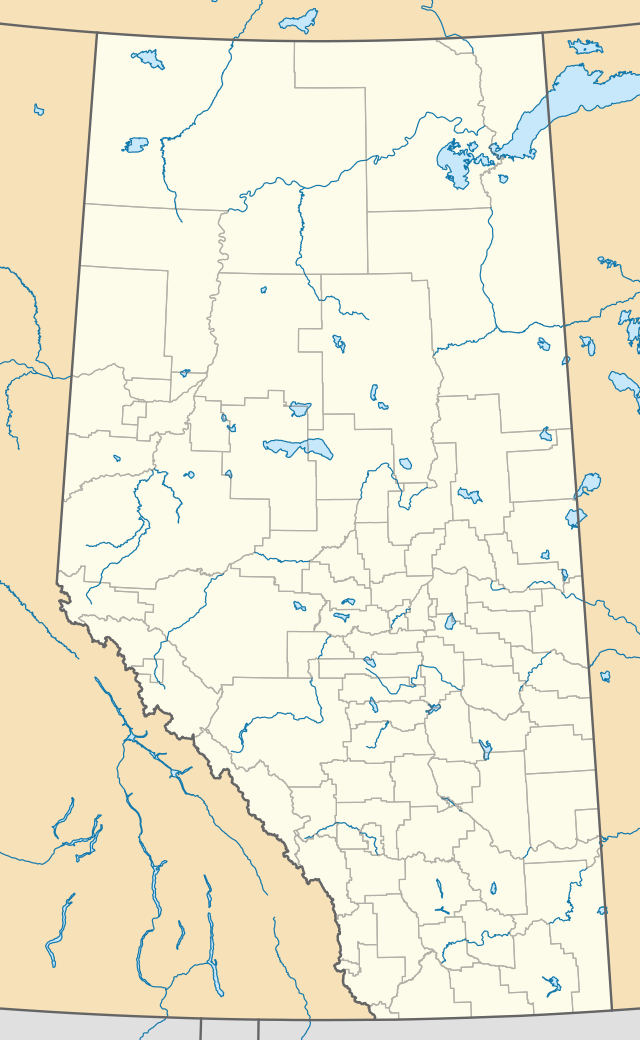Chisholm, Alberta
Chisholm, also known as Chisholm Mills, is a hamlet in Alberta, Canada, within the Municipal District of Lesser Slave River No. 124.[3] It is located 1 kilometre (0.62 mi) east of the Athabasca River, approximately 56 kilometres (35 mi) southeast of the Town of Slave Lake. The hamlet is served by both road (approximately 8.5 kilometres (5.3 mi) west of Highway 44) and rail (Canadian National Railway).
Chisholm
Chisholm Mills | |
|---|---|
Hamlet | |
 Chisholm Location of Chisholm in Alberta | |
| Coordinates: 54°54′34″N 114°10′08″W | |
| Country | Canada |
| Province | Alberta |
| Region | Northern Alberta |
| Census division | 17 |
| Municipal district | M.D. of Lesser Slave River No. 124 |
| Government | |
| • Type | Municipal District Council |
| • Reeve | Murray Kerik |
| • Governing body | M.D. of Lesser Slave River Council |
| • MP | Arnold Viersen (Peace River—Westlock-Cons) |
| • MLA | Danielle Larivee (Lesser Slave Lake-NDP) |
| Area | |
| • Land | 2.92 km2 (1.13 sq mi) |
| Elevation | 622 m (2,041 ft) |
| Population (2016)[2] | |
| • Total | 25 |
| Time zone | UTC−7 (MST) |
| • Summer (DST) | UTC−6 (MDT) |
| Postal code | T0G 0N0 |
| Area code(s) | 780, 587, 825 |
| Highways | Highway 44 8.8 kilometres (5.5 mi) east. |
| Waterways | Athabasca River |
| Website | MD of Lesser Slave River |
History
The community has the name of Thomas Chrisholm, an early settler.[4]
During World War II, there was a camp for German prisoners, Camp Chisholm.[5]
Demographics
As a designated place in the 2016 Census of Population conducted by Statistics Canada, Chisholm recorded a population of 25 living in 10 of its 18 total private dwellings, a change of 66.7% from its 2011 population of 15. With a land area of 2.92 km2 (1.13 sq mi), it had a population density of 8.6/km2 (22.2/sq mi) in 2016.[2]
As a designated place in the 2011 Census, Chisholm had a population of 15 living in 7 of its 8 total dwellings, a -25% change from its 2006 population of 20. With a land area of 2.84 km2 (1.10 sq mi), it had a population density of 5.28/km2 (13.7/sq mi) in 2011.[9]
See also
References
- "Municipal Officials Search". Alberta Municipal Affairs. 2017-09-22. Retrieved 2017-09-25.
- "Population and dwelling counts, for Canada, provinces and territories, and designated places, 2016 and 2011 censuses – 100% data (Alberta)". Statistics Canada. February 8, 2017. Retrieved February 13, 2017.
- Alberta Municipal Affairs (2010-04-01). "Specialized and Rural Municipalities and Their Communities" (PDF). Retrieved 2010-06-29.
- Place-names of Alberta. Ottawa: Geographic Board of Canada. 1928. p. 34.
- Conrad, Klaus. (2009). Canadian escapades-- Kanadische Eskapaden : the true story of the author's 3 escapes from WW2 POW camps (in German and English) (Bilingual ed.). Chelmsford, MA: Germancosm. p. 73. ISBN 978-0-9843271-0-2. Retrieved 2016-05-15.
- "Chisholm Fire Review Committee report" (on the internet); "Alberta charges rail companies in connection with forest fire". cbc.ca. 2001-11-19. Retrieved 2012-04-03.
- "CN to plead guilty in fire case, trial for RaiLink continues". cbc.ca. 2006-01-17. Retrieved 2012-04-03.
- "CN settles Alberta wildfire claims". cbc.ca. 2006-01-13. Retrieved 2012-04-03.
- "Population and dwelling counts, for Canada, provinces and territories, and designated places, 2011 and 2006 censuses (Alberta)". Statistics Canada. 2012-02-08. Retrieved 15 May 2016.